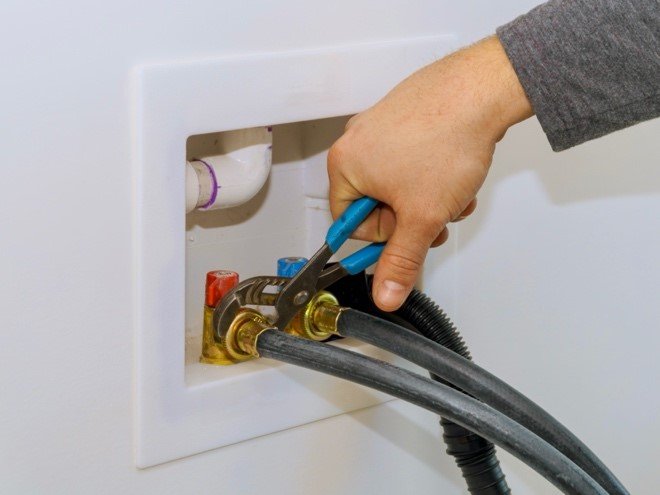One of the questions our home inspectors get quite frequently during a home inspection is “How do you replace washing machine hoses?” Fortunately, it’s a simple and relatively inexpensive process.
Hot and Cold Washing Machine Hoses
Washing machine hoses are one of those things in a home that are, for the most part, out of sight and out of mind. They are neglected, and unfortunately, a leak or some flooding may happen before they get the attention they deserve.
Our home inspectors come across washing machine hoses during inspections that may be leaking and have corroded connections. Sometimes our home inspectors find hoses with a large bulge in them that looks like it is about to burst.
Before You Get Started
Visit your favorite hardware or big box store and purchase a good set of washing machine hoses. This is not something you want to skimp on. I recommend a quality set of stainless-steel braided hoses. These are going to cost in the range of $30 to $35.
Tools and Supplies
· A large pair of channel lock pliers
· Bath towels
· 5-gallon bucket
Steps to Follow for Replacing Your Washing Machine Hoses
Turn off the water supply to the washing machine.
If you are lucky, this will be simple. There should be a service box in the wall or plumbing within a few feet of the washing machine that your washing machine hoses are connected to. Older homes with the laundry room in the basement may have old, corroded valves that may take a little work to close. If so, take your time and don’t force things. You don’t want to break a valve. If it looks like it may be beyond your skill set, it might be time to call a plumber.
Unplug the washing machine.
You may have to slide the washing machine away from the wall to get to the electrical plug and outlet. Unplug the washing machine to prevent an accidental shock. Sliding the washing machine away from the wall will also give you clear access to the washing machine’s hoses and valves.
Place one of your old bath towels on the floor below the washing machine hose hookups and have your bucket in place. There will be water in the hoses and most likely a little pressure, so you want to be ready to contain any leaks or dripping.
Disconnect the old washing machine hoses.
Washing machine hose connections are similar to a garden hose. Use your channel lock pliers to disconnect the end attached to the washing machine first. Remember: “Righty-tighty, lefty-loosey.” Place the disconnected end of the washing machine hose in the bucket, allowing the water to drain. Now disconnect the other end from the supply. Repeat for the other hose.
Be careful not to squeeze the pliers too hard, as the connections at the washing machine may be plastic. Also, pay attention to which washing machine hose is hot and which is cold.
Disconnecting, Connecting with a Channel Lock Pliers
Connect the new washing machine hoses.
Washing machine hoses, as we said earlier, are similar to a garden hose. Both ends have the same connector, so everything should hook back up pretty easily.
Attach the hot supply valve to the hot connector on the back of the washing machine, and the cold to the cold. Finger-tighten the washing machine hose connections first, then use your channel lock pliers to tighten them securely.
Note: Sometimes it can be easier to do one hose at a time, so you don’t accidentally get the hot and cold mixed up.
Turn the water supply back on.
Turn the water supply back on slowly, one valve at a time. Take a minute to observe and confirm that there are no leaks and that the connections are tight. Open the valve completely once you are sure there is no leak.
Once you are sure the first hose is okay, repeat the process for the other hose. Keep an eye on the newly installed washing machine hoses for a while before sliding the washing machine back up to the wall and reconnecting power. Keep your bucket, pliers, and towels handy in case there are any drips or leaks that need to be addressed.
Summary
You may not be able to call yourself a plumber just yet, but changing your washing machine hoses is a relatively simple project. It takes a little bit of time, but this easy DIY project can save you some money. If you are uncomfortable with any part of the process, it’s okay to call a plumber.
At HomePro Inspections, our home inspectors are trained to inspect plumbing systems and identify any defects. Any issues are documented in your home inspection report and recommended for resolution by a qualified professional.
Visit our website to learn more or to schedule your home inspection in the Rochester, Owatonna, and Faribault, MN areas. You can contact us today at (507) 202-8942 or utilize our online “Schedule Now” feature to set up an appointment.


